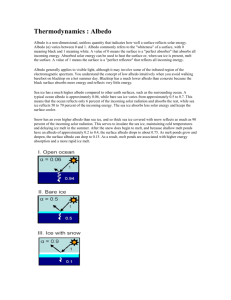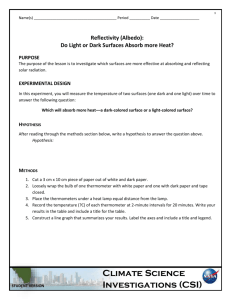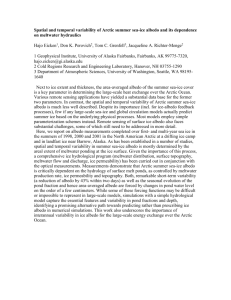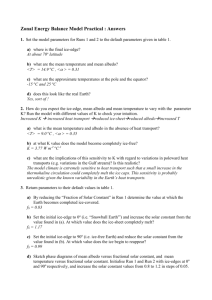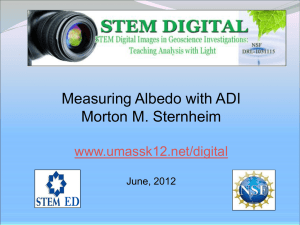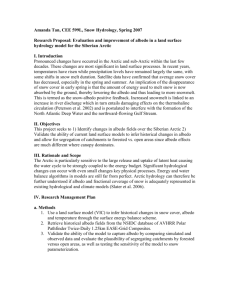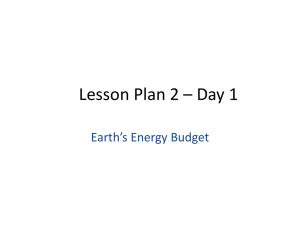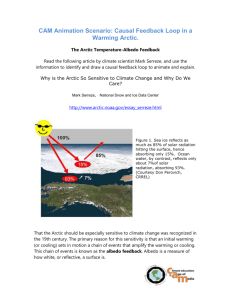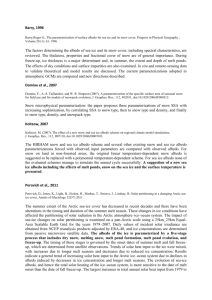Albedo Lab: Grade 9 Science - Ice Albedo Feedback
advertisement
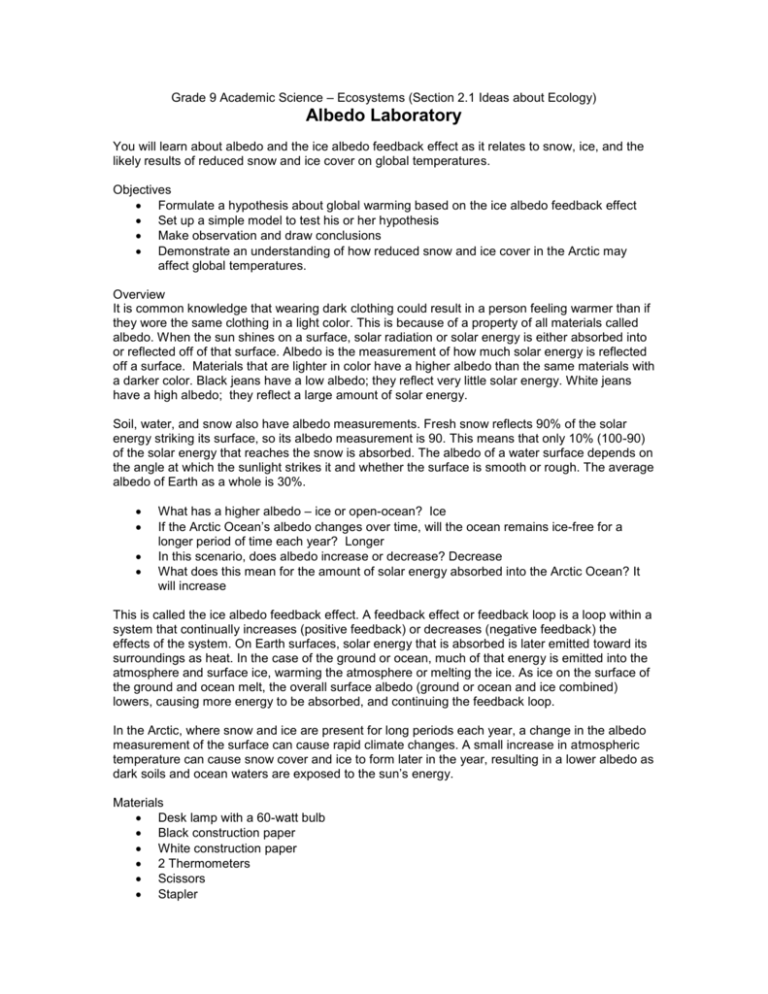
Grade 9 Academic Science – Ecosystems (Section 2.1 Ideas about Ecology) Albedo Laboratory You will learn about albedo and the ice albedo feedback effect as it relates to snow, ice, and the likely results of reduced snow and ice cover on global temperatures. Objectives Formulate a hypothesis about global warming based on the ice albedo feedback effect Set up a simple model to test his or her hypothesis Make observation and draw conclusions Demonstrate an understanding of how reduced snow and ice cover in the Arctic may affect global temperatures. Overview It is common knowledge that wearing dark clothing could result in a person feeling warmer than if they wore the same clothing in a light color. This is because of a property of all materials called albedo. When the sun shines on a surface, solar radiation or solar energy is either absorbed into or reflected off of that surface. Albedo is the measurement of how much solar energy is reflected off a surface. Materials that are lighter in color have a higher albedo than the same materials with a darker color. Black jeans have a low albedo; they reflect very little solar energy. White jeans have a high albedo; they reflect a large amount of solar energy. Soil, water, and snow also have albedo measurements. Fresh snow reflects 90% of the solar energy striking its surface, so its albedo measurement is 90. This means that only 10% (100-90) of the solar energy that reaches the snow is absorbed. The albedo of a water surface depends on the angle at which the sunlight strikes it and whether the surface is smooth or rough. The average albedo of Earth as a whole is 30%. What has a higher albedo – ice or open-ocean? Ice If the Arctic Ocean’s albedo changes over time, will the ocean remains ice-free for a longer period of time each year? Longer In this scenario, does albedo increase or decrease? Decrease What does this mean for the amount of solar energy absorbed into the Arctic Ocean? It will increase This is called the ice albedo feedback effect. A feedback effect or feedback loop is a loop within a system that continually increases (positive feedback) or decreases (negative feedback) the effects of the system. On Earth surfaces, solar energy that is absorbed is later emitted toward its surroundings as heat. In the case of the ground or ocean, much of that energy is emitted into the atmosphere and surface ice, warming the atmosphere or melting the ice. As ice on the surface of the ground and ocean melt, the overall surface albedo (ground or ocean and ice combined) lowers, causing more energy to be absorbed, and continuing the feedback loop. In the Arctic, where snow and ice are present for long periods each year, a change in the albedo measurement of the surface can cause rapid climate changes. A small increase in atmospheric temperature can cause snow cover and ice to form later in the year, resulting in a lower albedo as dark soils and ocean waters are exposed to the sun’s energy. Materials Desk lamp with a 60-watt bulb Black construction paper White construction paper 2 Thermometers Scissors Stapler Worksheet “Albedo Lab” Answer the question 1. What is albedo? a. Albedo is the percentage of radiant energy produced by the sun b. Albedo is the measure of how much radiant energy from the sun is reflected c. Albedo is the measure of how much radiant energy from the sun is absorbed Methods 1. Cut two 4 ¼” by 5 ½” squares, one from black construction paper, one from white construction paper. 2. Fold each square in half twice. 3. Staple two edges of each square to form pockets. 4. Place the bulb end of each thermometer into the pocket. 5. Place the thermometers directly under the lamp so that they receive equal amounts of light. The lamp should be pointed straight down. 6. Allow two minutes for the thermometers to reach the temperature of the surrounding air. This will be the initial temperature. Record this initial temperature on Table 1 7. Turn on the lamp. 8. Record the temperature of each thermometer (OC) every two minutes for the next 20 minutes. 9. Graph the data 10. Calculate the absolute and percent temperature change for each paper colour Hypothesis Make a prediction about the temperature of each thermometer How will the temperature of each thermometer change over time? Which will get warmer? Which will rise fastest? Table 1. Changes in Temperature for Different Coloured Papers over 20 minutes Time (min) Thermometer 0 2 4 6 8 10 12 14 16 18 White Paper Black Paper Questions 1. Assuming one paper represents an ocean (black) and the other ice (white), which surface has a higher albedo, ice or open-ocean based on your observations and calculations? 2. If an increase of 1OC in global temperatures causes the Arctic Ocean to remain ice free for two additional weeks each year, how will it affect the ocean’s albedo? Why? 3. If the ocean’s albedo decreases, how will this affect ocean temperatures and ice formation in the winter? Explain 20
